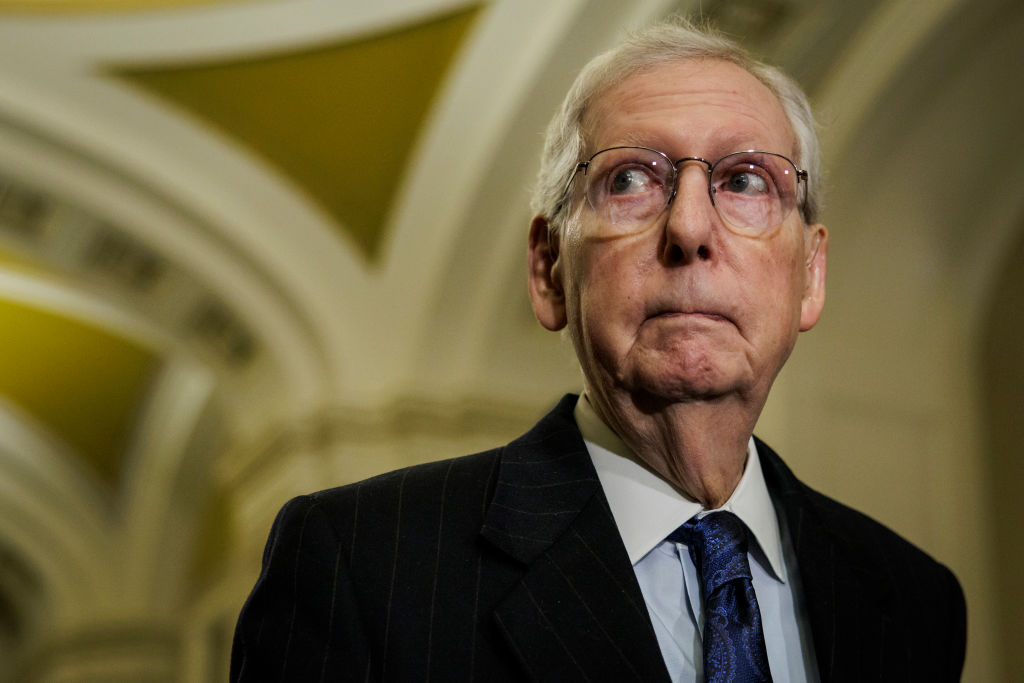To save American immigration policy, Trump must call for the Senate leader’s removal.
What Happened to My Party?

The Democrats need to appeal to Main Street America.
I grew up among people who worshipped the key pillars of the twentieth century Democratic Party: the New Deal, Franklin Roosevelt, and the great public works project known as New York City. The Democrats then were the party of progress—of new roads, bridges, ports, factories, and laboratories. They were also the party of national defense, a holdover from the triumph of World War II that was sustained by a fear of Communist aggression.
But the Democratic Party’s recent evolution contrasts sharply to its glory days. Today, the Democrats are losing out among some of the party’s core constituencies, notably those who work with their hands, Latinos, Jews, Asians, and even some African Americans. In their new configuration, the Democrats function as an electoral cabal forged by an alliance between the business elite, the professional classes, the federal bureaucracy, and dependent voters.
If anything, the Democrats synchronized swimming of the past month could only occur in a party largely uniform in its core constituencies and essential beliefs. They shift positions and allegiances through technology and media control, using influencers to hide troublesome past positions with a dexterity that a Communist vozdh like Joseph Stalin would have appreciated.
The new mindset is obvious considering the Democrats’ embrace of censorship in alliance with the tech oligarchs, who have been long-time backers of Kamala Harris, and the universities, another bulwark of progressive power. It also builds upon the assumption that the experts embraced by progressive voters should be allowed free reign since they know better than the masses.
The keys to understanding the increasingly authoritarian Democratic Party are threefold: class, racial politics, and sexual politics. As someone schooled in Marxist theory, I tend to place the class component first. In the past, Democrats were a party that appealed to “the little people” like factory hands, small shopkeepers, yeoman farmers, skilled mechanics, and artisans. Democrats from Kennedy to Clinton focused on private sector growth as a means to achieve upward mobility for middle- and working-class Americans.
But in the new Democratic policy world, most employment growth has been focused on government and public-funded health care. And the Democrats’ electoral base is largely those professionals who benefit from an expanded regulatory state.
The differences between the professional urban elect, who tend to cluster in college towns and dense big cities, and the bulk of the population are enormous. Indeed, a recent Rasmussen study of high-earning, grad-degree urban professionals found that their views on a host of issues such as restrictions on meat, gas, and free speech differ widely from most Americans.
These professionals, many of whom work in elite business services, prosper while the working and middle class that was once the Democratic base suffer. The inflation under Biden has been particularly hard among the less affluent. Overall, one in four Americans fear losing their job in the next year while roughly half of all U.S. adults surveyed now think the vaunted American Dream, as epitomized by opportunity for home ownership, has become unreachable, particularly in coastal cities.
It’s hard to see how a Harris-Walz regime would help address any of this. Both Harris and Walz have long embraced draconian climate regulation, with Harris even calling for the need to reduce population due to climate change.
Wherever these policies are implemented, as in California, the results for blue collar workers in terms of household costs and jobs tend to be disastrous. The pain is likely to spread soon if the U.S. auto industry, including GM, which Democrats once claimed would bring 10,000 new jobs to Michigan alone, continues to lay off workers to prepare for the forced march to electric vehicles. Overall, manufacturing is already in a recession.
The second leg of the current Democratic Party is racial politics. Having lost much of the old white working class, Democrats have focused on gaining non-white voters. The black political elite, in particular, helped elect Obama twice, nominated and elected Joe Biden, and were the force that elevated the formerly underwhelming Kamala Harris to the vice presidency.
To be sure, winning minority votes are clearly a key to future political success as they move toward being an absolute majority by mid-century. But the appeal to these voters has changed from a focus on equality of opportunity to the politics of racial redress. Democratic Party leaders endorse, for example, reparations for the descendants of slaves.
The “anti-racist” ideology so prevalent on college campuses and in the media has thrived in the new Democratic order. The Biden Department of Education embraces these ideas, with one top official having described democracy as being “built on white supremacy”; Biden’s White House Office of Science and Technology Policy (OSTP) has a similar focus.
Yet to play the race card, Democrats cannot just rely on black voters. To win in the future, they will have to add the much faster growing ranks of Asians and Latinos to the mix. Taken together, the Democrats’ control of “people of color” would all but guarantee victories into perpetuity.
But even among blacks, particularly young males, the bloody banner of race is losing out to the more immediate challenge of making a living. Blacks under Bidenomics have stagnated, and barely half approve of Biden’s performance, a very low number for an overwhelmingly Democratic group. Trump, at least until Harris’s impending nomination, was making unprecedented gains among blacks, achieving a remarkable 30 percent level of support among black male voters according to an April 2024 Wall Street Journal survey.
The shifts among Latinos are even more startling. Although most minority voters will support Harris, Republican support among Hispanic voters has grown by ten points since 2018. Trump now polls close to even, or even slightly ahead, with the largest of the growing demographic groups in the nation. That represents a dramatic change. In recent elections, Barack Obama won roughly 70 percent of the Latino vote.
A similar trend may be soon seen among Asians, who are now the U.S.’s fastest growing minority. As their numbers increase from almost 12 million in 2000 to more than three times that number by mid-century, they are showing growing unease with Democrats. Asian support for Trump rose from 27 percent in 2016 to 31 percent in 2020.
A particular sticking point is affirmative action, a policy Harris and the refashioned Democratic Party passionately embrace. Three-quarters of all Asian adults (76 percent) say race or ethnicity should not factor into college admissions decisions, and they voted decisively against a referendum to restore quotas in California.
And then there are the Jews. Democrats usually win something close to 70 percent of the Jewish vote. Though Jews are far less numerous than blacks and Asians, their financial support and political acumen are critical to the Democratic Party, as William Domhoff pointed out in his 1972 book Fat Cats and Democrats.
Yet as Democrats appeal to pro-Hamas voters and aligned groups like the teacher’s unions, they are turning off a sizable number of Jewish voters and contributors. In 2020, according to some estimates Trump gained almost a third of the Jewish vote, a six percent increase from 2016. A recent Siena poll suggested Trump had taken a lead among New York’s large Jewish population.
The third leg of the modern Democratic Party rests on sexual politics. Of course, the existence of a political gender gap is nothing new—but, according to recent Gallup surveys, it is now five times bigger than in 2000. Survey data has found that from 1999 to 2013, about three in ten women aged 18 to 29 consistently identified as liberal—which rose to 40 percent in 2023. Crucially, Gallup interprets these changes as “stronger-than-average pro-liberal shifts,” particularly at elite colleges. Some of this can be traced to issues like abortion. Also, married women are far more likely to lean center-right than their unmarried and childless counterparts.
In contrast, young men are increasingly supportive of Donald Trump, reflecting deep dissatisfaction with the Democrats’ economic agenda. Recent polling suggests that young voters, particularly from the working class, are shifting away from the Democrats, who won their votes easily in 2020.
In the short term, the Democrats will benefit from the decline in marriage, family formation, and birthrates—and the rise of so-called “cat ladies.” But in the long term, this could prove a problem, as there are much higher birth rates in red states than blue ones, which demographer Lyman Stone has called the “conservative fertility advantage.”
In today’s demographics, Democrats could put together a majority coalition even as they continue to hemorrhage working-class voters due in part because independent and suburban voters, particularly women, tend to dislike Trump. But over time, the long term prognosis for the GOP improves as Democrats are forced to appease minorities, gender radicals, and anti-Israel activists, who are likely to be a disruptive presence at the Democratic National Convention and throughout the rest of the 2024 campaign.
Ironically, a Harris victory could prove over time an unmitigated disaster for Democrats, particularly once there is no Trump to rally against. The Harris-Waltz regime would likely be Bidenism on steroids, accelerating welfare spending, weakening national defense, and, wherever possible, raising the level of regulation and taxes. The disorder of Democratic-controlled cities won’t provide a great advertisement for progressive policies.
The key is whether conservatives can use these failures to appeal to groups outside the MAGA core. There are signs that minority voters are restless, backing more moderate candidates in Buffalo and Seattle. Similar shifts have taken place in Virginia, which saw the election of a Jamaican-American as lieutenant governor and a Cuban-American as attorney general.
But perhaps the real battle, particularly if Harris loses, may come within the Democratic Party, sparked by the vehemence of anti-Israel Democrats as well as Biden’s feckless policies. Mainstream Democratic Jews have already deposed two members of the radical “squad” and are aiming at more. The successful victories by moderates in the Democratic stronghold of San Francisco, with similar efforts underway in Los Angeles and Oakland, make clear that even big city voters have had it with deep blue politics.
Whether this winter or four years hence, the Democrats will need to recalibrate their political approach. As a fellow at the Democratic Leadership Council’s policy think tank, I saw how the party was able to recover from the disasters of the McGovern and Mondale campaigns. The key challenge then, like now, is to reconnect the party with the denizens of Main Street America and the heartland, notably parents, suburban-dwellers, and upwardly mobile minorities.
Of course, as the old Yiddish saying has it, from my lips to God’s ears. Party reform is possible but will take a prolonged struggle in the years following the 2024 election, and victory is far from assured. So for the time being, I am staying as I have been for years—a homeless, former Democrat.
The American Mind presents a range of perspectives. Views are writers’ own and do not necessarily represent those of The Claremont Institute.
The American Mind is a publication of the Claremont Institute, a non-profit 501(c)(3) organization, dedicated to restoring the principles of the American Founding to their rightful, preeminent authority in our national life. Interested in supporting our work? Gifts to the Claremont Institute are tax-deductible.
Reviving the Hamiltonian spirit in an era of populism.
Is a cultural renaissance in the works?
Mass migration has radicalized the United Kingdom.
Vice President Harris learned at the side of a brilliant, cynical political master.
A clarifying exchange.






